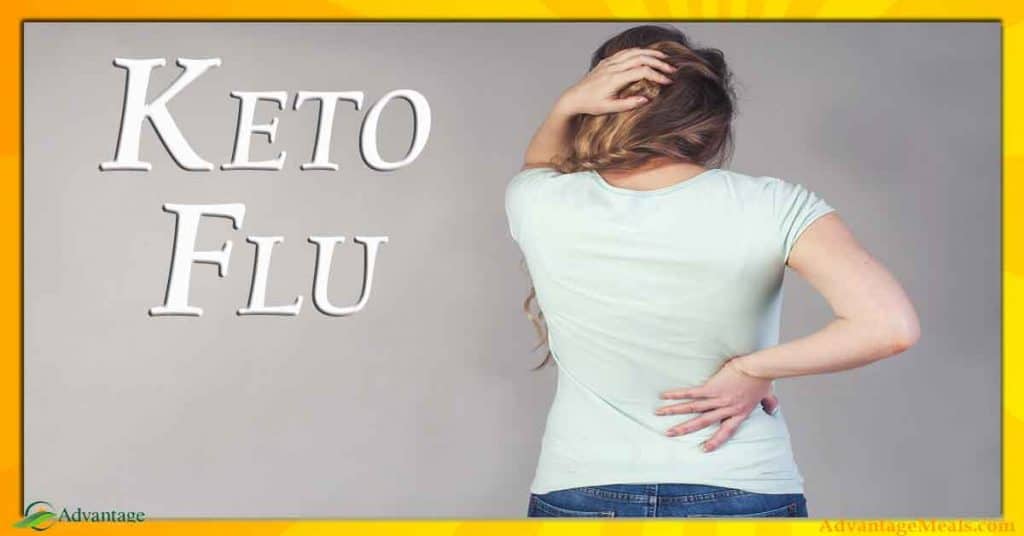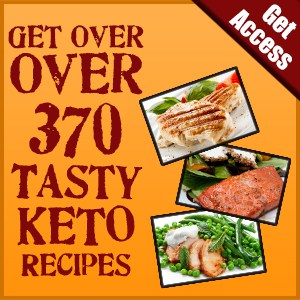This site may contain links to affiliate websites, and we receive an affiliate commission for any purchases made by you on the affiliate website using such links.
The Keto Flu sucks.
With symptoms like headache, nausea, dizziness, muscle cramps, and irritability, it’s enough to make anyone wonder if a Keto diet is worth it. The keto flu is really not the flu at all, and it is absolutely beatable and worth the effort!
To be clear, keto flu symptoms are not caused by the Keto Diet itself.
They are caused by carb withdrawal. Those keto flu symptoms are uncomfortable, but once your body has made the transition to ketosis, you will be glad you stuck with it.
We’re here to help with the “low carb flu” symptoms with tips and remedies.
What is Keto Flu?
Keto flu is a commonly used phrase to describe the symptoms of your body transitioning from burning sugar to burning fat as its main fuel source.
It takes different mechanisms inside your cells to process fat and ketones than it does sugar, and if your body has never made the switch between these fuel sources before, it can be hard. Like any skill in life, it takes practice and a little time to get good at it.
Not everyone gets keto flu when starting a ketogenic diet, but most people do.
Some people experience mild keto flu, while others suffer from lots of symptoms.
Particularly for people who have been reliant on a high carbohydrate diet for their whole life, breaking that reliance can be difficult and they seem to experience more symptoms of keto flu.
It’s much like drug addiction, with sugar and carbs as the drug.
Your body is used to having carbs to burn, and even though those carbs are causing health problems, taking them away causes symptoms of withdrawal.
The good news is, it will pass! You can do this, and the benefits will be worth it.
Most people who experience keto flu start to feel the symptoms on days 2-4 of eating a ketogenic diet.
For most people, it’s over in about a week, though some may continue to experience symptoms for 3-5 weeks, that is less common.
The second cause of keto flu is electrolyte imbalance.
This is something that you need to be aware of not just during the transition but always when you are in ketosis. A ketogenic diet is a diuretic by nature (meaning it flushes water out of your system). When you flush water out of your cells, it also takes electrolytes with it. These include sodium, magnesium, potassium, and calcium.
Making sure you drink enough water and taking in these important minerals is important for everyone on Keto.

List of Keto Flu Symptoms
Each individual body reacts differently during the transition to ketosis, so while this list looks daunting, you probably won’t experience all of these.
Just know that if you are feeling any of these low-carb flu symptoms, it is normal and it will pass! Some of these are caused by carb withdrawal and some may be due to electrolyte imbalances. We’ll address how you can help alleviate these below.
- Sugar cravings
- Fatigue
- Headache
- Dizziness
- Irritability
- Muscle cramps
- Nausea
- Constipation
- Diarrhea
- Heartburn
List of 12 DIY Keto Flu Remedies
#1 – Drink lots of water. Since your body is releasing lots of water that it has been retaining, you need to make sure you are drinking plenty of water. The good news is, you’ll be less bloated since you’re not retaining that water anymore! Drinking plenty of water ensures you won’t get dehydrated, which can lead to more headaches and other keto flu symptoms. Some coffee is fine but avoid too much, as it will dehydrate you, too. Avoid diet soda, as well. It is dehydrating and the artificial sweeteners can actually increase your cravings for carbs and sugar.
#2 – Add minerals to your water. We use ConcenTrace Trace Mineral Drops in every glass of water we drink. We add 5-10 drops to a 24-ounce glass and drink at least 4 glasses each day. The magnesium in these drops makes a huge difference, and this is a habit you may want to continue daily on your keto journey. If we don’t use these minerals in our water, we start to notice muscle cramps within 24 hours.
#3 – Drink and cook with bone broth. Bone broth is chock full of beneficial nutrients, including some calcium, magnesium, and potassium. It also contains collagen and a number of other proteins that are very healing for your digestive system. It can soothe some of the digestive discomforts you are experiencing and also help heal the lining of your gut and reduce inflammation. Learn more about the benefits and how you can make your own, or buy a high-quality brand. We like the Kettle and Fire brand.
#4 – Salt your food. Sodium is excreted in large amounts on a ketogenic diet, and you need to make sure you are including this vital mineral. Many keto experts recommend 2000 – 4000 mg or more of sodium per day, through food and added salt. We use pink sea salt because it contains other trace minerals, as well as sodium. Everyone who undertakes a keto diet should consult with their doctor before beginning, but this is particularly important for people who are on medications that are diuretic (such as Lasix). If you have concerns about medications or sodium intake, make sure to talk to your doctor.
#5 – Sleep. Get at least 7 ½ hours of sleep every night. Your cells do the majority of their work while you are asleep, so help yourself out and make sure you are getting plenty. And be kind to yourself during this transition period into ketosis. Rest when you need it.
#6 – Exercise. Light exercise like walking is good because it naturally draws on the fat-burning mechanisms in your cells. If you’re up for it, you can also do 10-15 minutes of high-intensity interval training. This will use up the glycogen in your muscles, and with the absence of carbs in your diet, your body will begin to replenish that glycogen using the fat burning and ketogenic pathways faster. Don’t overdo it, though! If you’re feeling miserable, adding the physical stress of intense exercise is probably not right for you.
#7 – Epsom salt bath. This is a good way to pamper yourself, and it also increases magnesium. Epsom salts contain magnesium, and it can be absorbed through your skin. Add 1-2 cups of Epsom salts to a warm bath while the water is running to help dissolve the salts. Soak for at least 12 minutes, or longer if you can! Do not use Epsom salts in a jetted tub, hot tub, or whirlpool unless approved by the manufacturer.
#8 – Eat nutrient-dense foods. High-quality whole foods support your body in lots of ways, which will help you transition to ketosis faster and experience fewer symptoms of keto flu. Keto-friendly foods that are high in magnesium, potassium, calcium, and sodium include avocado, spinach, almonds, canned salmon (with bones), canned tuna, broccoli, celery, peanut butter, macadamia nuts, olives, cheese, and asparagus, among others. If you’re using our No Cook Keto Plan: 3 Easy Weeks to Success, it is optimized with all of these foods and will ensure that you are getting as much of the electrolytes you need from your food as possible.
#9 – Do not add carbs. Keep your carbs as low as you can while you are transitioning. Cheating just makes it harder. You might be tempted to curb a sugar craving with “just a little” sugar. This will only make it take longer to get into ketosis and thus to get past the keto flu! Remember you are trying to beat an addiction. Heroin addicts in rehab don’t get “just a little” heroine to make it easier. You can do this!
#10 – Add fat and calories, if needed. Many people just starting a keto diet mistakenly believe that they have to restrict calories to deprivation levels in order to lose weight. Years of Conventional Wisdom teaching us that calorie restriction is the only way to lose weight is powerful and hard to overcome. The same goes for including more fat. Fat is your friend, and you need it to feel satisfied, make ketones, and tell your body that you are not starving and it’s safe to burn your stored body fat for fuel.
#11 – Consider including MCT oil and coconut. Coconut contains medium-chain triglycerides (MCTs). Their chemical structure and shape make them more readily used by the body for fuel and to make ketones. Some people find that including them helps them reach ketosis faster. Add them in slowly, as some people experience digestive upset when incorporating too much, too fast. MCT oil is virtually tasteless, so you can add it to just about anything. For coconut, try this recipe for Chocolate Coconut Fat Bombs!
#12 – Potassium supplementation. We do not generally recommend supplementing potassium, as the form that is in most supplements (potassium chloride and salts) can cause problems in high doses. Also, potassium in foods is more readily absorbed by the body than magnesium, so you are less likely to be deficient in potassium if you are eating potassium-rich foods. (Eat your avocados and green veggies!) If you have tried all the remedies above and still feel you need something more, try adding a little bit of Morton Lite Salt to your food. This actually contains potassium and is a good way to boost your intake.

About The Author Of These Keto Diet Tips

Angela Davis
Founder Advantage Meals
Angela earned her Master’s Degree in Holistic Nutrition 14 years ago and began her lifelong journey of nutrition and wellness learning. She began keto meal planning and cooking over a decade ago when she began working with local clients who were under the direct supervision of a medical doctor. Angela is the author of No Cook Keto, the easiest keto meal plan available.
Disclaimer: I am neither a licensed nutritionist nor a medical professional. I never prescribe diets. I only share my personal experiences and those of my clients for informational purposes only. Nutrition details are provided for informational purposes only, and should not be considered medical nutritional data. You should consult your medical professional before making any major changes in the way you eat.
~Angela



Your chocolate coconut fat bomb link doesn’t work😭
Thanks for letting us know. I’ve fixed it in the article, but just in case, here’s a link to the Chocolate Coconut Fat Bomb Recipe.
Where do you get the mineral drops? Do you have to order on line? I have never seen them.
You can get them on Amazon { Affiliate Link to Drops on Amazon >> }, but you can also usually find them in higher-end health/grocery stores.